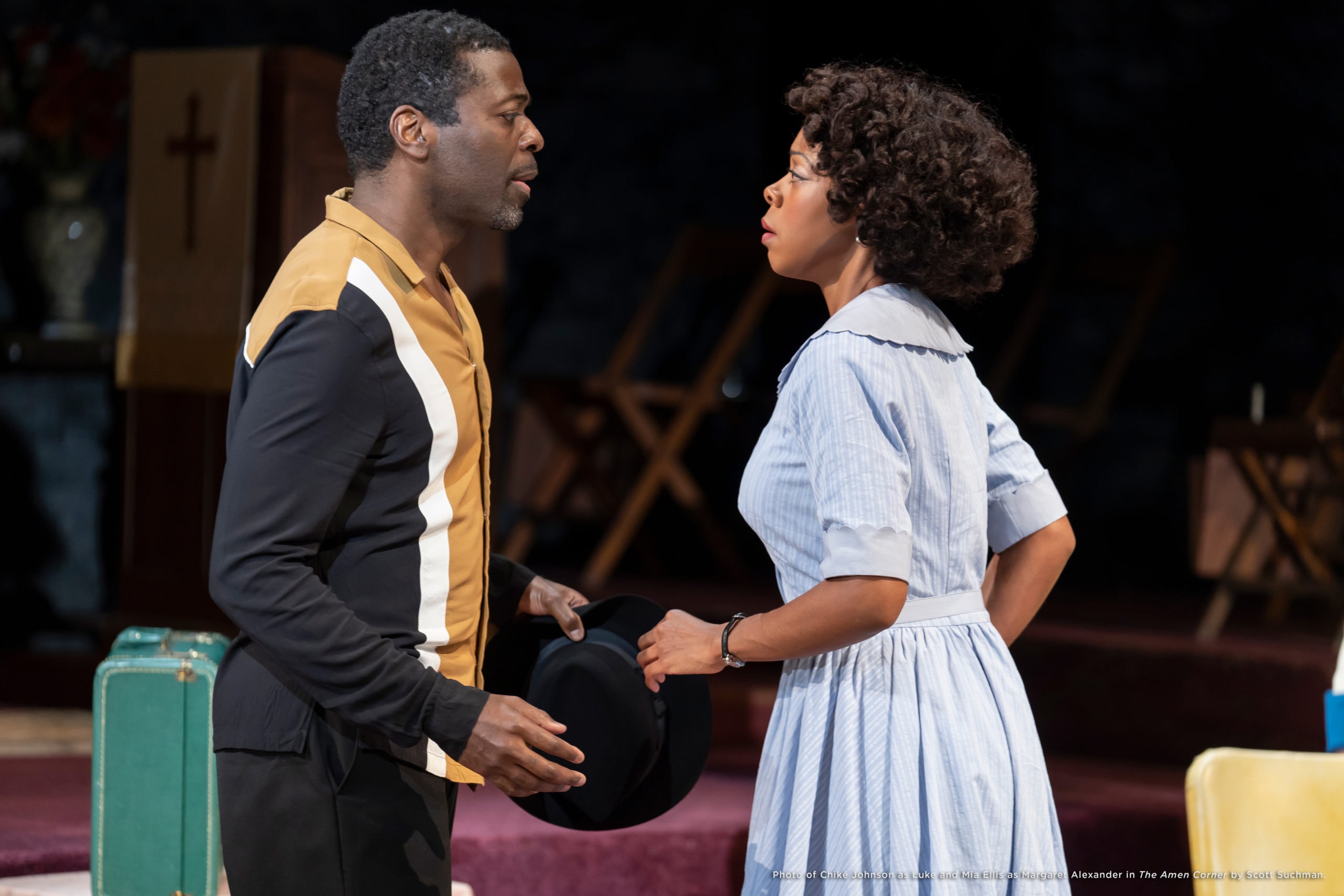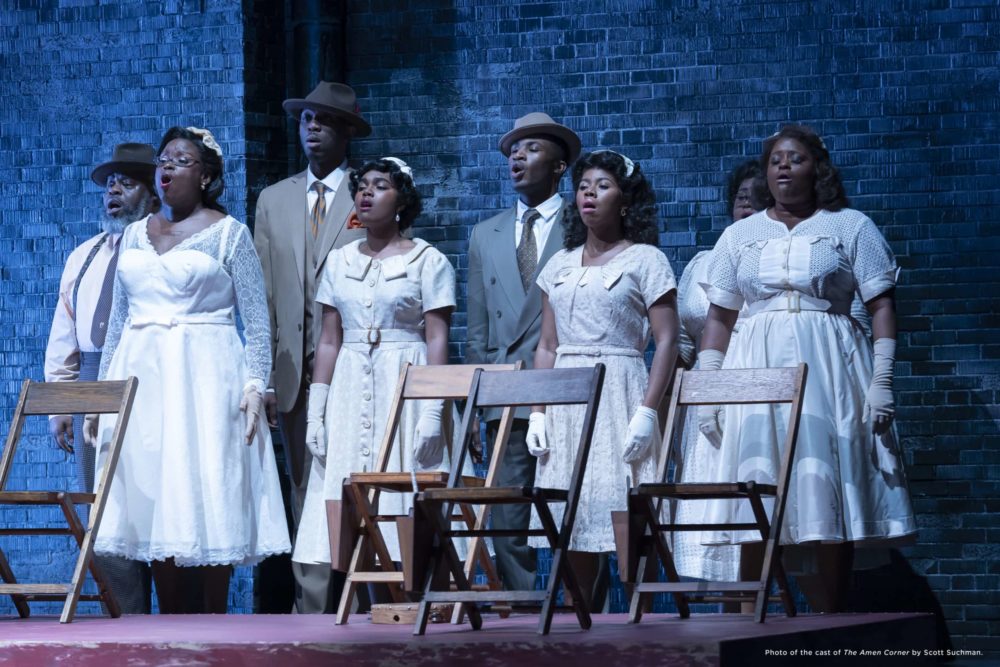Corners can be safe spaces for hiding. There’s comfort in corners because they’re out of sight and out of danger. In The Amen Corner, James Baldwin’s dilemma is whether to embrace the inner life of the Black Church or the outer world of street life. Neither corner is a safe space in America.

The pulpit plays protagonist in the amazing grace of The Amen Corner where this existential duality follows the pastoral presence of Sister Margaret Alexander, her son, congregants, and an estranged husband.
With the brilliant directorial conception of Whitney White, who recently helmed Aleshea Harris’ ritualistic What to Send up When It Goes Down at Woolly Mammoth Theatre, The Amen Corner also pays homage to ritual through the vernacular of the Black Church in the rhythm, music, and movement of this emotionally moving play-with-music.
And oh, how glorious is the music. Under Music Director Victor Simonson, the affirmation of song completes each dramatic crescendo. Just like a Greek chorus that exchanges tragedy for jubilation, the choir’s powerfully pleasing voices could resurrect Dionysius. The soul-stirring singing adds clout to a joyous shout, while the piano man takes the jazz out of the club and blasts it at the altar.
Get-happy praise dance adds frenetic energy to gospel music that’s divinely right on time, and there are enough hallelujahs to lift the soul as well as the rafters of the Shakespeare Theatre Company’s Sidney Harman Hall.
With this production, The Amen Corner is back home again. In 1955, the historically black campus of Howard University was its birthplace. It would take another decade before the show made it to Broadway. The Amen Corner comes full circle, returning again to DC, but in the traditionally white environs of a Shakespearean hangout.

Perhaps Baldwin knew he was ahead of his time, but went ahead anyway and created the first of only two plays he wrote. And perhaps he knew that the secret to finding a safe space in America was to find it within the freedom of one’s authentic self — and all the human complexity that entails. The Amen Corner courageously preaches a sermon that freedom comes without the safety of a corner in which to hide.
Like Sister Margaret who has to deal with the false piety that confines her spirit, Mia Ellis’ moving portrayal is passion personified but without the peace that surpasses all understanding she tries to sell from the pulpit.
David, Sister Margaret’s wannabe-worldly son, yearns to use his talents as a jazz musician and gain the freedom to be his own man. Antonio Michael Woodard plays David with an anxious edginess bursting to be free of the religious constraints of his tyrannical mother and the Black Church.
His father, the down-on-his-luck Luke, has been absent from David’s life for a decade, but is the catalyst for David’s liberation when he reappears and stirs up the sweet taste of independence. Chiké Johnson gives a dynamite performance as the gritty but oh-so-real Luke, a man “full of his sins,” whom a hypocritical church disdains when he returns to Margaret’s doorstep and her love-starved arms.
A colorful cast of characters fills the rest of the church pews with joy and laughter as well as pain and suffering. E. Faye Butler is over-the-top as the entertaining but back-stabbing Sister Moore, a gossipy rumor-monger. But O, Lordy, can Sister Moore belt out a spirit-filled song. Nova Y. Payton’s singing as Sister Douglass is a heavenly gift.

Along with husband-and-wife Sister and Brother Boxer (Deidra LaWan Starnes and Phil McGlaston), the three lead the pack in triangulating the loss of faith in Sister Margaret’s pastoring, while Odessa (Harriett D. Foy), Margaret’s eternally faithful sister, is a bulwark of Christian compassion.
The Beloved Community is at the heart of The Amen Corner’s message. But the heart is on trial in a village struggling to express love when the real issue is lack of self-love and yearnings that cannot be hidden in safe spaces.
Scenic Designer Daniel Soule opens the inner workings of the community with a set that hides nothing; the interiors of a simple bedroom and a church, the kitchen as heart of the home, a Harlem tenement’s brick walls, open windows that function as peepholes, and laundry blowing near a rundown fire-escape stairwell are in full view. The exterior cannot camouflage the interior. Two become one, both literally and figuratively.
The Amen Corner is exquisitely well-done; it is entertaining but full of profundity in an American classic kind of way. Breathtaking in passionate simplicity and life-giving in self-affirming authenticity, it’s a must-see.
Running Time: Two hours and 30 minutes, including one 15-minute intermission
The Amen Corner plays from February 11 through March 15, 2020, at the Harman Center for the Arts, Sidney Harman Hall, 610 F Street, NW, Washington, DC. For tickets, call the box office at (202) 547-1122, or go online.
READ John Stoltenberg’s Magic Time! interview, Whitney White on directing James Baldwin’s classic ‘The Amen Corner’ at Shakespeare Theatre Company




